Evaluating Tourism Planning and Environment in Great Barrier Reef
VerifiedAdded on 2023/06/07
|19
|4593
|51
Report
AI Summary
This report examines tourism planning and its effects on the environment of the Great Barrier Reef, focusing on issues such as environmental pressures, pollution, and the impact of tourism on employment and income in Australia. It discusses the role of government, adaptation to unexpected changes, maintaining uniqueness, and avoiding undesirable outcomes, highlighting the importance of stakeholder involvement and the challenges faced in the planning process. The report also emphasizes the need for a new policy to manage emerging problems, promote sustainable tourism, and ensure the long-term preservation of the Great Barrier Reef's natural resources. Desklib provides access to similar assignments and study tools for students.
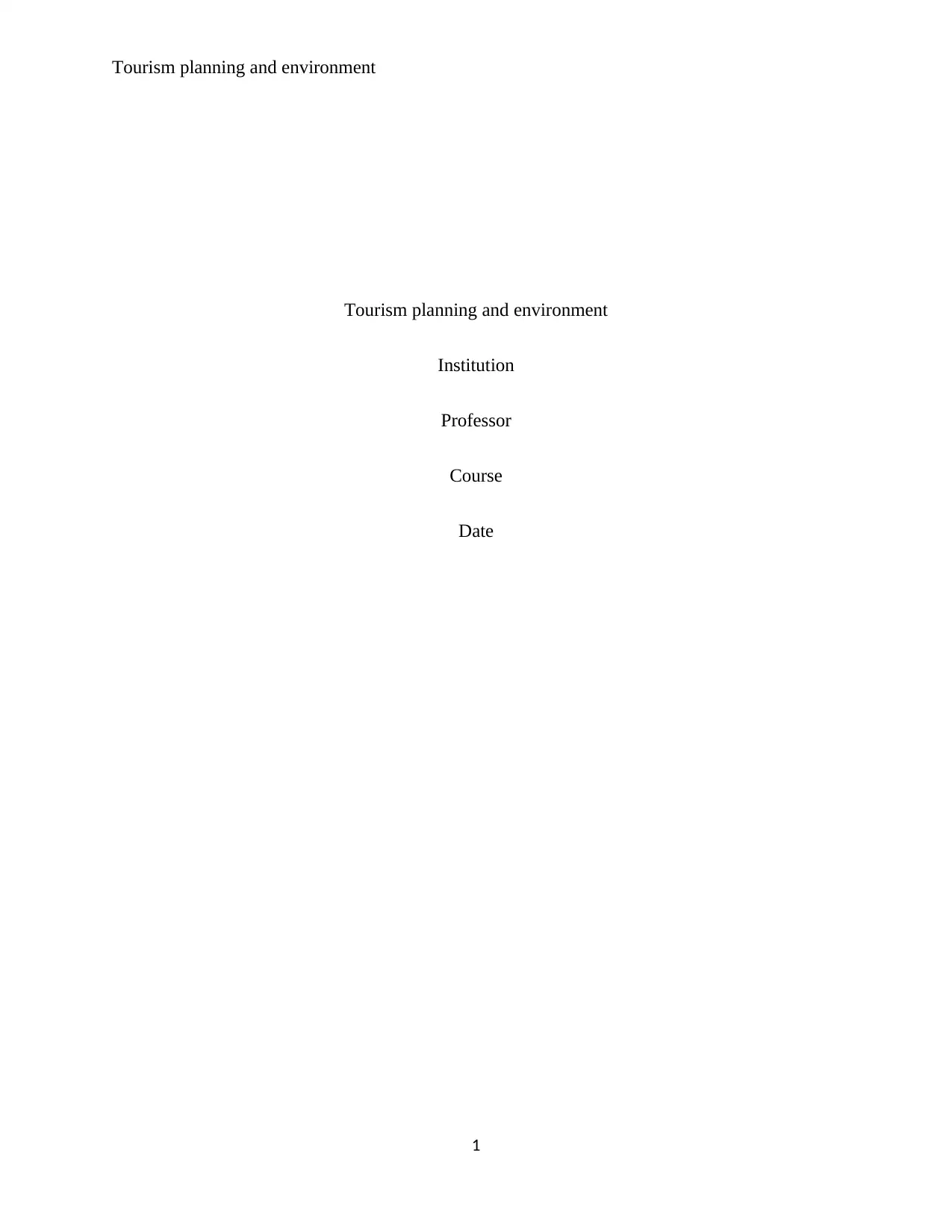
Tourism planning and environment
Tourism planning and environment
Institution
Professor
Course
Date
1
Tourism planning and environment
Institution
Professor
Course
Date
1
Paraphrase This Document
Need a fresh take? Get an instant paraphrase of this document with our AI Paraphraser
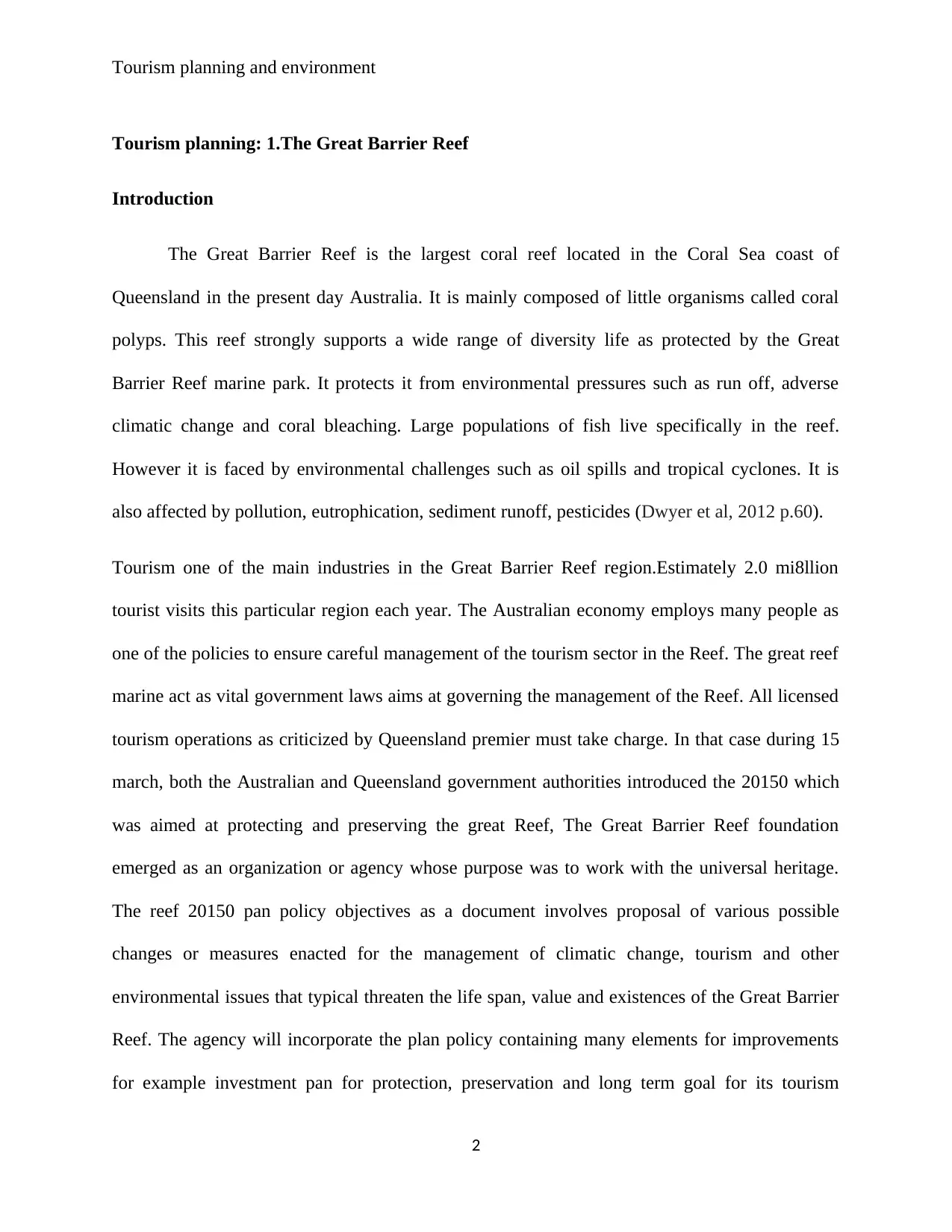
Tourism planning and environment
Tourism planning: 1.The Great Barrier Reef
Introduction
The Great Barrier Reef is the largest coral reef located in the Coral Sea coast of
Queensland in the present day Australia. It is mainly composed of little organisms called coral
polyps. This reef strongly supports a wide range of diversity life as protected by the Great
Barrier Reef marine park. It protects it from environmental pressures such as run off, adverse
climatic change and coral bleaching. Large populations of fish live specifically in the reef.
However it is faced by environmental challenges such as oil spills and tropical cyclones. It is
also affected by pollution, eutrophication, sediment runoff, pesticides (Dwyer et al, 2012 p.60).
Tourism one of the main industries in the Great Barrier Reef region.Estimately 2.0 mi8llion
tourist visits this particular region each year. The Australian economy employs many people as
one of the policies to ensure careful management of the tourism sector in the Reef. The great reef
marine act as vital government laws aims at governing the management of the Reef. All licensed
tourism operations as criticized by Queensland premier must take charge. In that case during 15
march, both the Australian and Queensland government authorities introduced the 20150 which
was aimed at protecting and preserving the great Reef, The Great Barrier Reef foundation
emerged as an organization or agency whose purpose was to work with the universal heritage.
The reef 20150 pan policy objectives as a document involves proposal of various possible
changes or measures enacted for the management of climatic change, tourism and other
environmental issues that typical threaten the life span, value and existences of the Great Barrier
Reef. The agency will incorporate the plan policy containing many elements for improvements
for example investment pan for protection, preservation and long term goal for its tourism
2
Tourism planning: 1.The Great Barrier Reef
Introduction
The Great Barrier Reef is the largest coral reef located in the Coral Sea coast of
Queensland in the present day Australia. It is mainly composed of little organisms called coral
polyps. This reef strongly supports a wide range of diversity life as protected by the Great
Barrier Reef marine park. It protects it from environmental pressures such as run off, adverse
climatic change and coral bleaching. Large populations of fish live specifically in the reef.
However it is faced by environmental challenges such as oil spills and tropical cyclones. It is
also affected by pollution, eutrophication, sediment runoff, pesticides (Dwyer et al, 2012 p.60).
Tourism one of the main industries in the Great Barrier Reef region.Estimately 2.0 mi8llion
tourist visits this particular region each year. The Australian economy employs many people as
one of the policies to ensure careful management of the tourism sector in the Reef. The great reef
marine act as vital government laws aims at governing the management of the Reef. All licensed
tourism operations as criticized by Queensland premier must take charge. In that case during 15
march, both the Australian and Queensland government authorities introduced the 20150 which
was aimed at protecting and preserving the great Reef, The Great Barrier Reef foundation
emerged as an organization or agency whose purpose was to work with the universal heritage.
The reef 20150 pan policy objectives as a document involves proposal of various possible
changes or measures enacted for the management of climatic change, tourism and other
environmental issues that typical threaten the life span, value and existences of the Great Barrier
Reef. The agency will incorporate the plan policy containing many elements for improvements
for example investment pan for protection, preservation and long term goal for its tourism
2
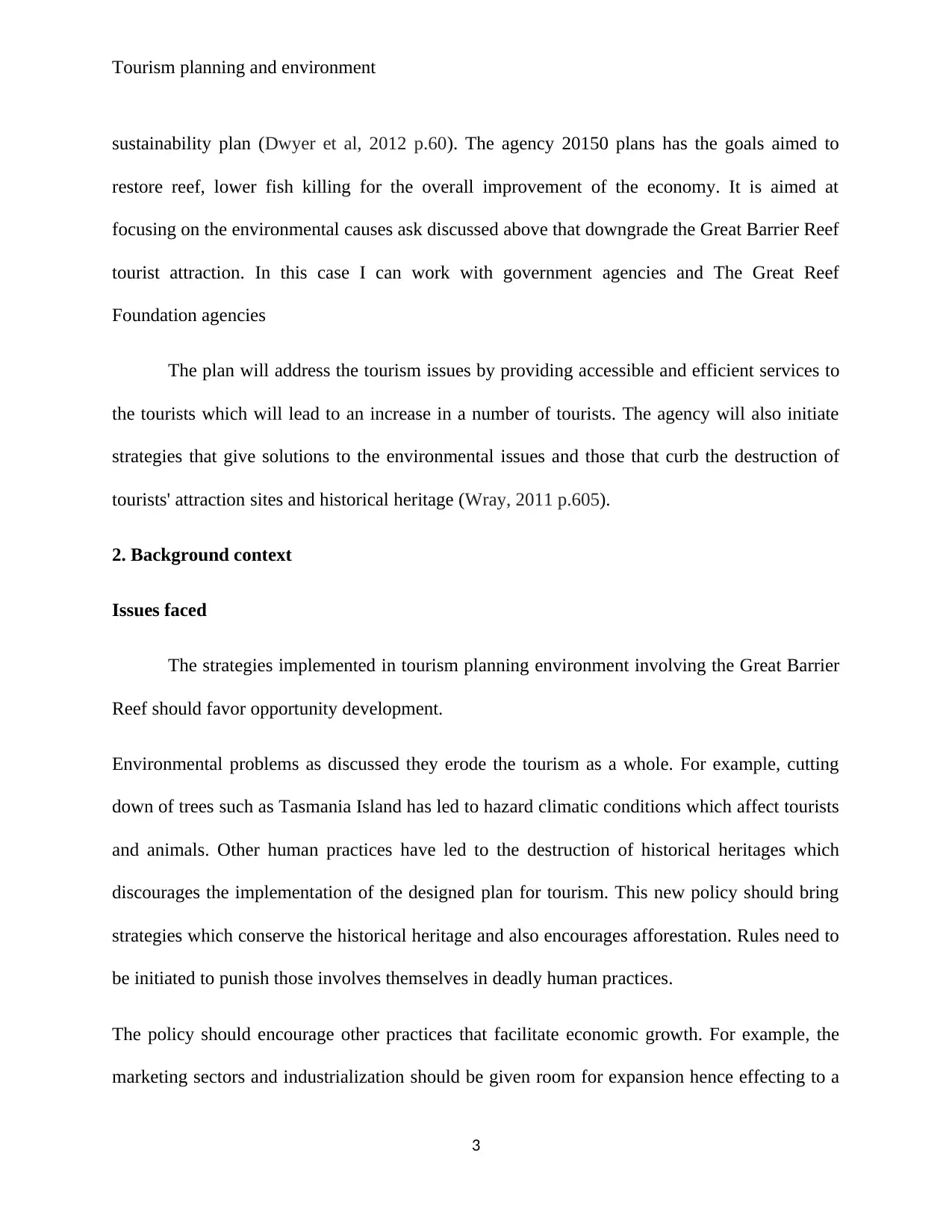
Tourism planning and environment
sustainability plan (Dwyer et al, 2012 p.60). The agency 20150 plans has the goals aimed to
restore reef, lower fish killing for the overall improvement of the economy. It is aimed at
focusing on the environmental causes ask discussed above that downgrade the Great Barrier Reef
tourist attraction. In this case I can work with government agencies and The Great Reef
Foundation agencies
The plan will address the tourism issues by providing accessible and efficient services to
the tourists which will lead to an increase in a number of tourists. The agency will also initiate
strategies that give solutions to the environmental issues and those that curb the destruction of
tourists' attraction sites and historical heritage (Wray, 2011 p.605).
2. Background context
Issues faced
The strategies implemented in tourism planning environment involving the Great Barrier
Reef should favor opportunity development.
Environmental problems as discussed they erode the tourism as a whole. For example, cutting
down of trees such as Tasmania Island has led to hazard climatic conditions which affect tourists
and animals. Other human practices have led to the destruction of historical heritages which
discourages the implementation of the designed plan for tourism. This new policy should bring
strategies which conserve the historical heritage and also encourages afforestation. Rules need to
be initiated to punish those involves themselves in deadly human practices.
The policy should encourage other practices that facilitate economic growth. For example, the
marketing sectors and industrialization should be given room for expansion hence effecting to a
3
sustainability plan (Dwyer et al, 2012 p.60). The agency 20150 plans has the goals aimed to
restore reef, lower fish killing for the overall improvement of the economy. It is aimed at
focusing on the environmental causes ask discussed above that downgrade the Great Barrier Reef
tourist attraction. In this case I can work with government agencies and The Great Reef
Foundation agencies
The plan will address the tourism issues by providing accessible and efficient services to
the tourists which will lead to an increase in a number of tourists. The agency will also initiate
strategies that give solutions to the environmental issues and those that curb the destruction of
tourists' attraction sites and historical heritage (Wray, 2011 p.605).
2. Background context
Issues faced
The strategies implemented in tourism planning environment involving the Great Barrier
Reef should favor opportunity development.
Environmental problems as discussed they erode the tourism as a whole. For example, cutting
down of trees such as Tasmania Island has led to hazard climatic conditions which affect tourists
and animals. Other human practices have led to the destruction of historical heritages which
discourages the implementation of the designed plan for tourism. This new policy should bring
strategies which conserve the historical heritage and also encourages afforestation. Rules need to
be initiated to punish those involves themselves in deadly human practices.
The policy should encourage other practices that facilitate economic growth. For example, the
marketing sectors and industrialization should be given room for expansion hence effecting to a
3
⊘ This is a preview!⊘
Do you want full access?
Subscribe today to unlock all pages.

Trusted by 1+ million students worldwide
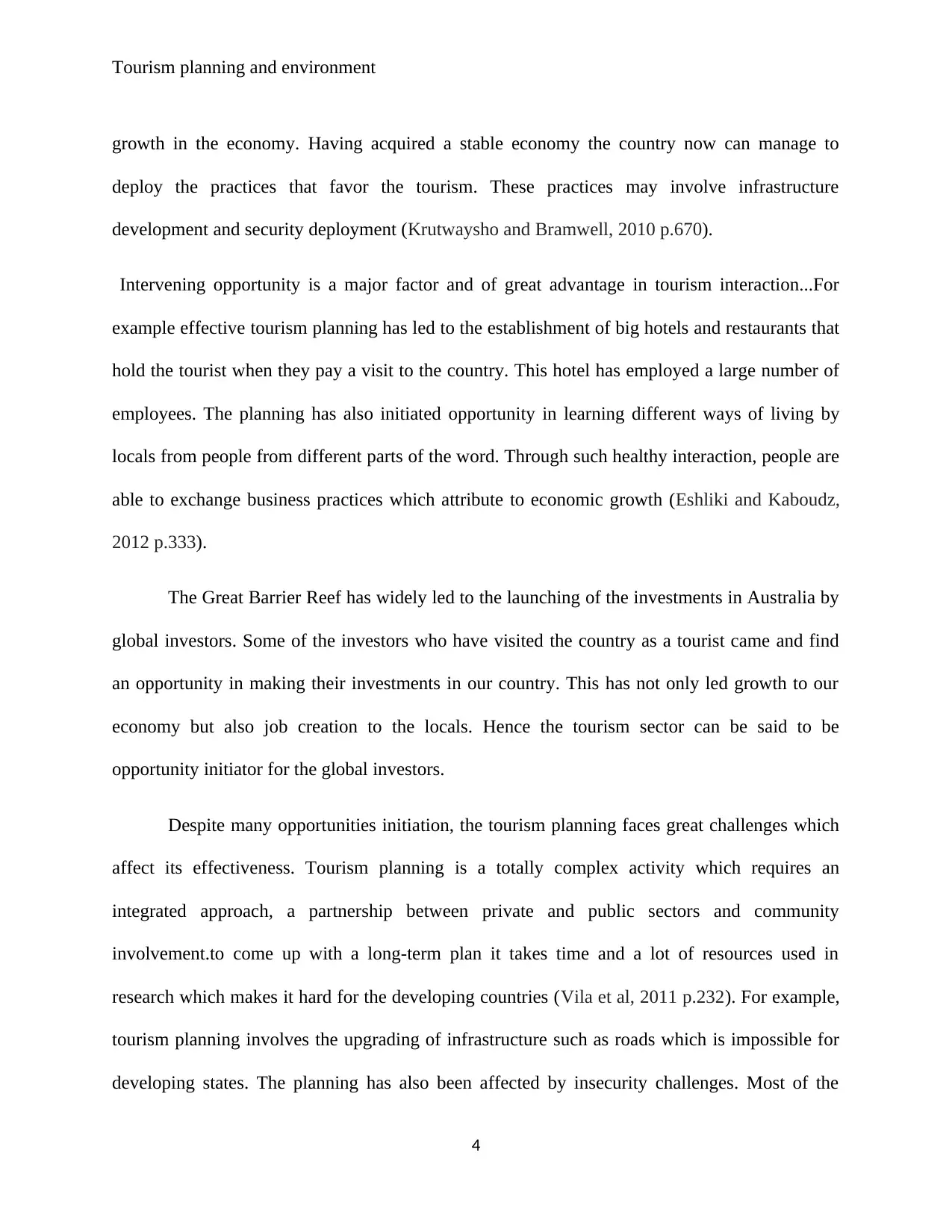
Tourism planning and environment
growth in the economy. Having acquired a stable economy the country now can manage to
deploy the practices that favor the tourism. These practices may involve infrastructure
development and security deployment (Krutwaysho and Bramwell, 2010 p.670).
Intervening opportunity is a major factor and of great advantage in tourism interaction...For
example effective tourism planning has led to the establishment of big hotels and restaurants that
hold the tourist when they pay a visit to the country. This hotel has employed a large number of
employees. The planning has also initiated opportunity in learning different ways of living by
locals from people from different parts of the word. Through such healthy interaction, people are
able to exchange business practices which attribute to economic growth (Eshliki and Kaboudz,
2012 p.333).
The Great Barrier Reef has widely led to the launching of the investments in Australia by
global investors. Some of the investors who have visited the country as a tourist came and find
an opportunity in making their investments in our country. This has not only led growth to our
economy but also job creation to the locals. Hence the tourism sector can be said to be
opportunity initiator for the global investors.
Despite many opportunities initiation, the tourism planning faces great challenges which
affect its effectiveness. Tourism planning is a totally complex activity which requires an
integrated approach, a partnership between private and public sectors and community
involvement.to come up with a long-term plan it takes time and a lot of resources used in
research which makes it hard for the developing countries (Vila et al, 2011 p.232). For example,
tourism planning involves the upgrading of infrastructure such as roads which is impossible for
developing states. The planning has also been affected by insecurity challenges. Most of the
4
growth in the economy. Having acquired a stable economy the country now can manage to
deploy the practices that favor the tourism. These practices may involve infrastructure
development and security deployment (Krutwaysho and Bramwell, 2010 p.670).
Intervening opportunity is a major factor and of great advantage in tourism interaction...For
example effective tourism planning has led to the establishment of big hotels and restaurants that
hold the tourist when they pay a visit to the country. This hotel has employed a large number of
employees. The planning has also initiated opportunity in learning different ways of living by
locals from people from different parts of the word. Through such healthy interaction, people are
able to exchange business practices which attribute to economic growth (Eshliki and Kaboudz,
2012 p.333).
The Great Barrier Reef has widely led to the launching of the investments in Australia by
global investors. Some of the investors who have visited the country as a tourist came and find
an opportunity in making their investments in our country. This has not only led growth to our
economy but also job creation to the locals. Hence the tourism sector can be said to be
opportunity initiator for the global investors.
Despite many opportunities initiation, the tourism planning faces great challenges which
affect its effectiveness. Tourism planning is a totally complex activity which requires an
integrated approach, a partnership between private and public sectors and community
involvement.to come up with a long-term plan it takes time and a lot of resources used in
research which makes it hard for the developing countries (Vila et al, 2011 p.232). For example,
tourism planning involves the upgrading of infrastructure such as roads which is impossible for
developing states. The planning has also been affected by insecurity challenges. Most of the
4
Paraphrase This Document
Need a fresh take? Get an instant paraphrase of this document with our AI Paraphraser
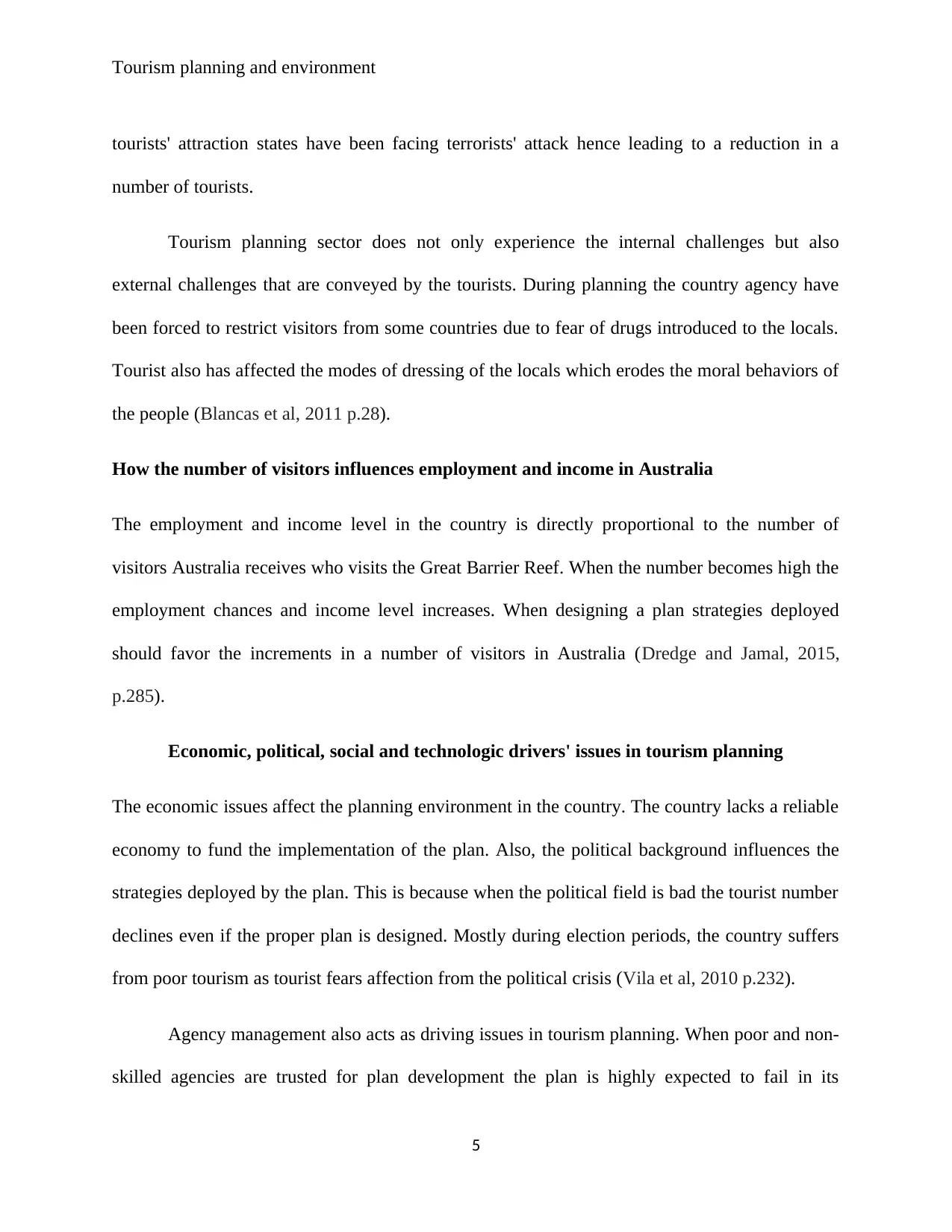
Tourism planning and environment
tourists' attraction states have been facing terrorists' attack hence leading to a reduction in a
number of tourists.
Tourism planning sector does not only experience the internal challenges but also
external challenges that are conveyed by the tourists. During planning the country agency have
been forced to restrict visitors from some countries due to fear of drugs introduced to the locals.
Tourist also has affected the modes of dressing of the locals which erodes the moral behaviors of
the people (Blancas et al, 2011 p.28).
How the number of visitors influences employment and income in Australia
The employment and income level in the country is directly proportional to the number of
visitors Australia receives who visits the Great Barrier Reef. When the number becomes high the
employment chances and income level increases. When designing a plan strategies deployed
should favor the increments in a number of visitors in Australia (Dredge and Jamal, 2015,
p.285).
Economic, political, social and technologic drivers' issues in tourism planning
The economic issues affect the planning environment in the country. The country lacks a reliable
economy to fund the implementation of the plan. Also, the political background influences the
strategies deployed by the plan. This is because when the political field is bad the tourist number
declines even if the proper plan is designed. Mostly during election periods, the country suffers
from poor tourism as tourist fears affection from the political crisis (Vila et al, 2010 p.232).
Agency management also acts as driving issues in tourism planning. When poor and non-
skilled agencies are trusted for plan development the plan is highly expected to fail in its
5
tourists' attraction states have been facing terrorists' attack hence leading to a reduction in a
number of tourists.
Tourism planning sector does not only experience the internal challenges but also
external challenges that are conveyed by the tourists. During planning the country agency have
been forced to restrict visitors from some countries due to fear of drugs introduced to the locals.
Tourist also has affected the modes of dressing of the locals which erodes the moral behaviors of
the people (Blancas et al, 2011 p.28).
How the number of visitors influences employment and income in Australia
The employment and income level in the country is directly proportional to the number of
visitors Australia receives who visits the Great Barrier Reef. When the number becomes high the
employment chances and income level increases. When designing a plan strategies deployed
should favor the increments in a number of visitors in Australia (Dredge and Jamal, 2015,
p.285).
Economic, political, social and technologic drivers' issues in tourism planning
The economic issues affect the planning environment in the country. The country lacks a reliable
economy to fund the implementation of the plan. Also, the political background influences the
strategies deployed by the plan. This is because when the political field is bad the tourist number
declines even if the proper plan is designed. Mostly during election periods, the country suffers
from poor tourism as tourist fears affection from the political crisis (Vila et al, 2010 p.232).
Agency management also acts as driving issues in tourism planning. When poor and non-
skilled agencies are trusted for plan development the plan is highly expected to fail in its
5
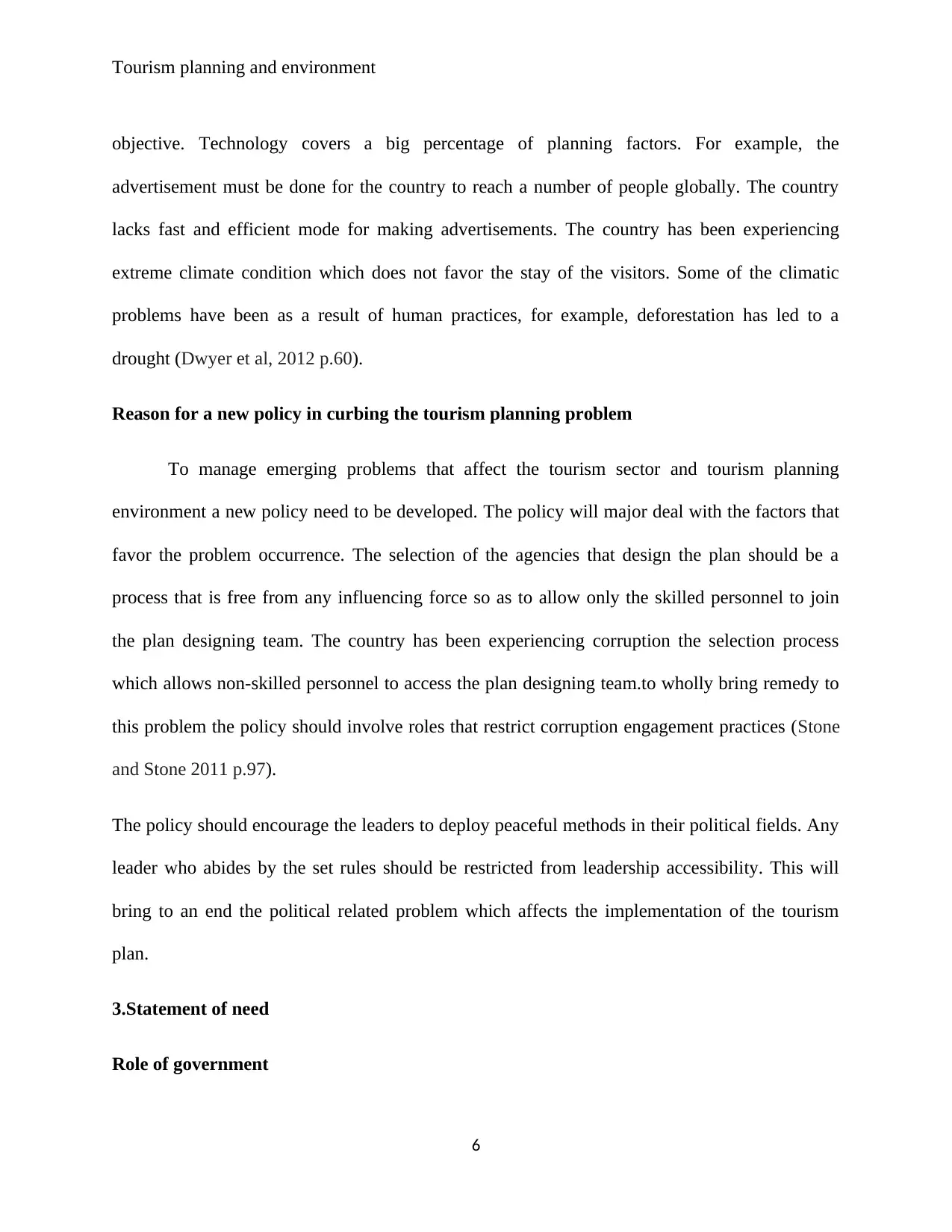
Tourism planning and environment
objective. Technology covers a big percentage of planning factors. For example, the
advertisement must be done for the country to reach a number of people globally. The country
lacks fast and efficient mode for making advertisements. The country has been experiencing
extreme climate condition which does not favor the stay of the visitors. Some of the climatic
problems have been as a result of human practices, for example, deforestation has led to a
drought (Dwyer et al, 2012 p.60).
Reason for a new policy in curbing the tourism planning problem
To manage emerging problems that affect the tourism sector and tourism planning
environment a new policy need to be developed. The policy will major deal with the factors that
favor the problem occurrence. The selection of the agencies that design the plan should be a
process that is free from any influencing force so as to allow only the skilled personnel to join
the plan designing team. The country has been experiencing corruption the selection process
which allows non-skilled personnel to access the plan designing team.to wholly bring remedy to
this problem the policy should involve roles that restrict corruption engagement practices (Stone
and Stone 2011 p.97).
The policy should encourage the leaders to deploy peaceful methods in their political fields. Any
leader who abides by the set rules should be restricted from leadership accessibility. This will
bring to an end the political related problem which affects the implementation of the tourism
plan.
3.Statement of need
Role of government
6
objective. Technology covers a big percentage of planning factors. For example, the
advertisement must be done for the country to reach a number of people globally. The country
lacks fast and efficient mode for making advertisements. The country has been experiencing
extreme climate condition which does not favor the stay of the visitors. Some of the climatic
problems have been as a result of human practices, for example, deforestation has led to a
drought (Dwyer et al, 2012 p.60).
Reason for a new policy in curbing the tourism planning problem
To manage emerging problems that affect the tourism sector and tourism planning
environment a new policy need to be developed. The policy will major deal with the factors that
favor the problem occurrence. The selection of the agencies that design the plan should be a
process that is free from any influencing force so as to allow only the skilled personnel to join
the plan designing team. The country has been experiencing corruption the selection process
which allows non-skilled personnel to access the plan designing team.to wholly bring remedy to
this problem the policy should involve roles that restrict corruption engagement practices (Stone
and Stone 2011 p.97).
The policy should encourage the leaders to deploy peaceful methods in their political fields. Any
leader who abides by the set rules should be restricted from leadership accessibility. This will
bring to an end the political related problem which affects the implementation of the tourism
plan.
3.Statement of need
Role of government
6
⊘ This is a preview!⊘
Do you want full access?
Subscribe today to unlock all pages.

Trusted by 1+ million students worldwide
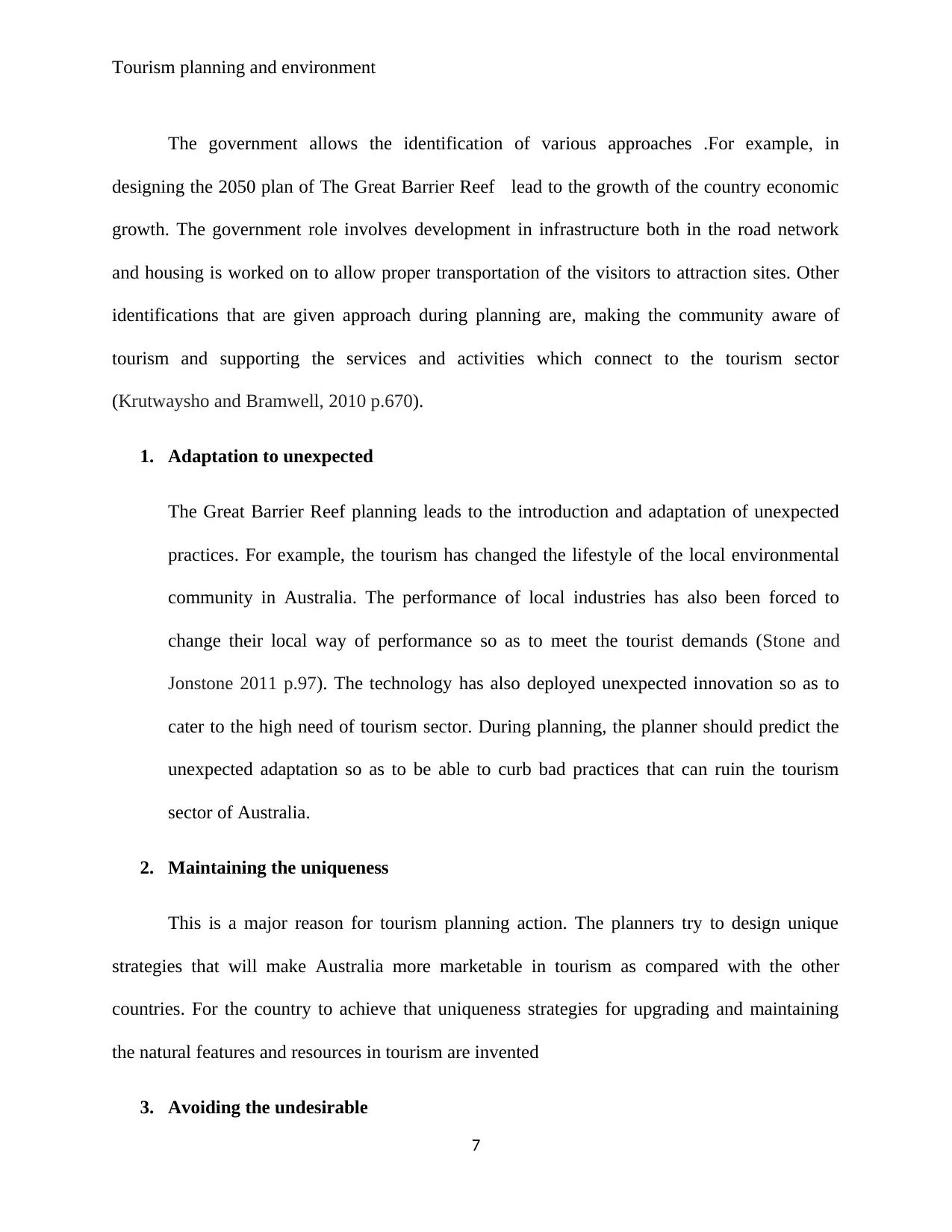
Tourism planning and environment
The government allows the identification of various approaches .For example, in
designing the 2050 plan of The Great Barrier Reef lead to the growth of the country economic
growth. The government role involves development in infrastructure both in the road network
and housing is worked on to allow proper transportation of the visitors to attraction sites. Other
identifications that are given approach during planning are, making the community aware of
tourism and supporting the services and activities which connect to the tourism sector
(Krutwaysho and Bramwell, 2010 p.670).
1. Adaptation to unexpected
The Great Barrier Reef planning leads to the introduction and adaptation of unexpected
practices. For example, the tourism has changed the lifestyle of the local environmental
community in Australia. The performance of local industries has also been forced to
change their local way of performance so as to meet the tourist demands (Stone and
Jonstone 2011 p.97). The technology has also deployed unexpected innovation so as to
cater to the high need of tourism sector. During planning, the planner should predict the
unexpected adaptation so as to be able to curb bad practices that can ruin the tourism
sector of Australia.
2. Maintaining the uniqueness
This is a major reason for tourism planning action. The planners try to design unique
strategies that will make Australia more marketable in tourism as compared with the other
countries. For the country to achieve that uniqueness strategies for upgrading and maintaining
the natural features and resources in tourism are invented
3. Avoiding the undesirable
7
The government allows the identification of various approaches .For example, in
designing the 2050 plan of The Great Barrier Reef lead to the growth of the country economic
growth. The government role involves development in infrastructure both in the road network
and housing is worked on to allow proper transportation of the visitors to attraction sites. Other
identifications that are given approach during planning are, making the community aware of
tourism and supporting the services and activities which connect to the tourism sector
(Krutwaysho and Bramwell, 2010 p.670).
1. Adaptation to unexpected
The Great Barrier Reef planning leads to the introduction and adaptation of unexpected
practices. For example, the tourism has changed the lifestyle of the local environmental
community in Australia. The performance of local industries has also been forced to
change their local way of performance so as to meet the tourist demands (Stone and
Jonstone 2011 p.97). The technology has also deployed unexpected innovation so as to
cater to the high need of tourism sector. During planning, the planner should predict the
unexpected adaptation so as to be able to curb bad practices that can ruin the tourism
sector of Australia.
2. Maintaining the uniqueness
This is a major reason for tourism planning action. The planners try to design unique
strategies that will make Australia more marketable in tourism as compared with the other
countries. For the country to achieve that uniqueness strategies for upgrading and maintaining
the natural features and resources in tourism are invented
3. Avoiding the undesirable
7
Paraphrase This Document
Need a fresh take? Get an instant paraphrase of this document with our AI Paraphraser
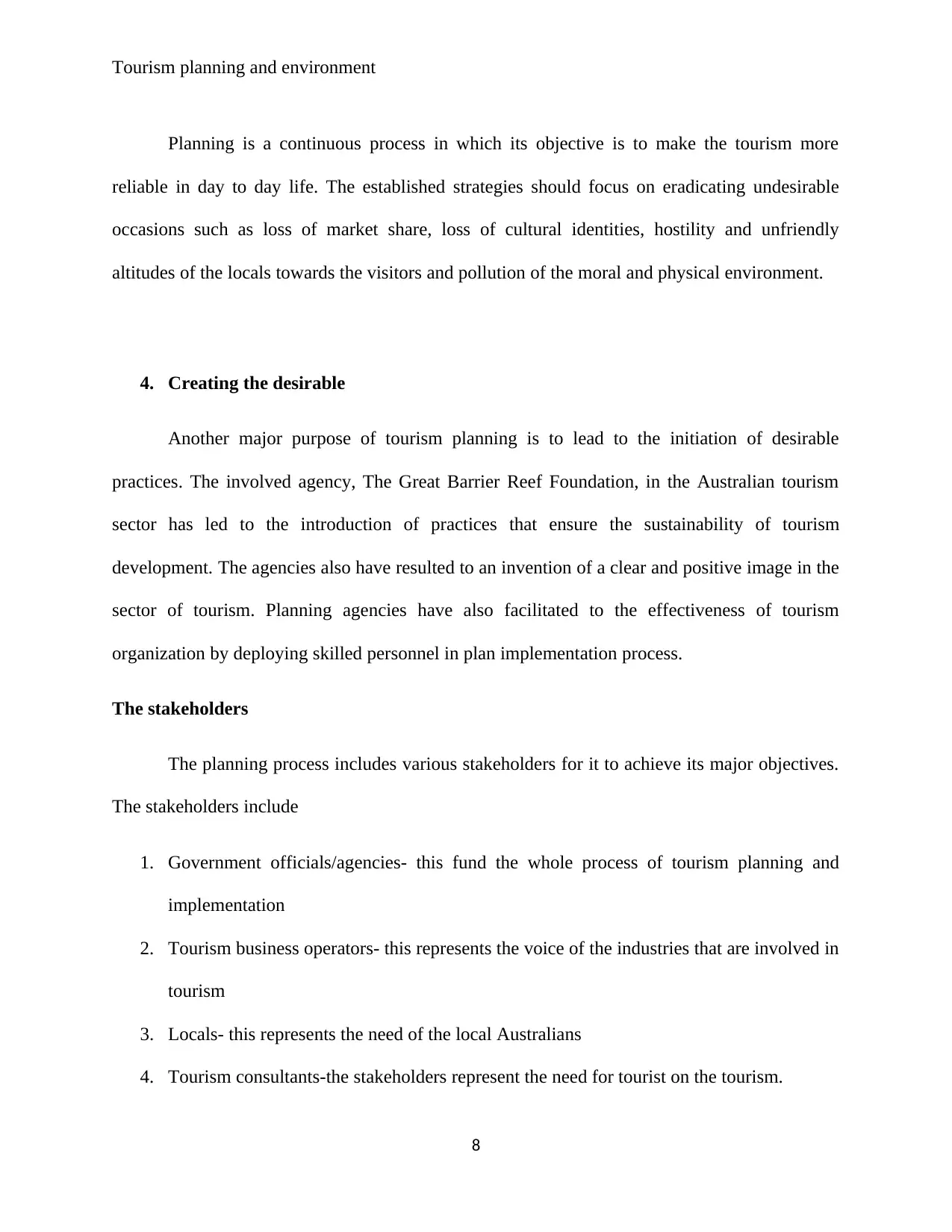
Tourism planning and environment
Planning is a continuous process in which its objective is to make the tourism more
reliable in day to day life. The established strategies should focus on eradicating undesirable
occasions such as loss of market share, loss of cultural identities, hostility and unfriendly
altitudes of the locals towards the visitors and pollution of the moral and physical environment.
4. Creating the desirable
Another major purpose of tourism planning is to lead to the initiation of desirable
practices. The involved agency, The Great Barrier Reef Foundation, in the Australian tourism
sector has led to the introduction of practices that ensure the sustainability of tourism
development. The agencies also have resulted to an invention of a clear and positive image in the
sector of tourism. Planning agencies have also facilitated to the effectiveness of tourism
organization by deploying skilled personnel in plan implementation process.
The stakeholders
The planning process includes various stakeholders for it to achieve its major objectives.
The stakeholders include
1. Government officials/agencies- this fund the whole process of tourism planning and
implementation
2. Tourism business operators- this represents the voice of the industries that are involved in
tourism
3. Locals- this represents the need of the local Australians
4. Tourism consultants-the stakeholders represent the need for tourist on the tourism.
8
Planning is a continuous process in which its objective is to make the tourism more
reliable in day to day life. The established strategies should focus on eradicating undesirable
occasions such as loss of market share, loss of cultural identities, hostility and unfriendly
altitudes of the locals towards the visitors and pollution of the moral and physical environment.
4. Creating the desirable
Another major purpose of tourism planning is to lead to the initiation of desirable
practices. The involved agency, The Great Barrier Reef Foundation, in the Australian tourism
sector has led to the introduction of practices that ensure the sustainability of tourism
development. The agencies also have resulted to an invention of a clear and positive image in the
sector of tourism. Planning agencies have also facilitated to the effectiveness of tourism
organization by deploying skilled personnel in plan implementation process.
The stakeholders
The planning process includes various stakeholders for it to achieve its major objectives.
The stakeholders include
1. Government officials/agencies- this fund the whole process of tourism planning and
implementation
2. Tourism business operators- this represents the voice of the industries that are involved in
tourism
3. Locals- this represents the need of the local Australians
4. Tourism consultants-the stakeholders represent the need for tourist on the tourism.
8
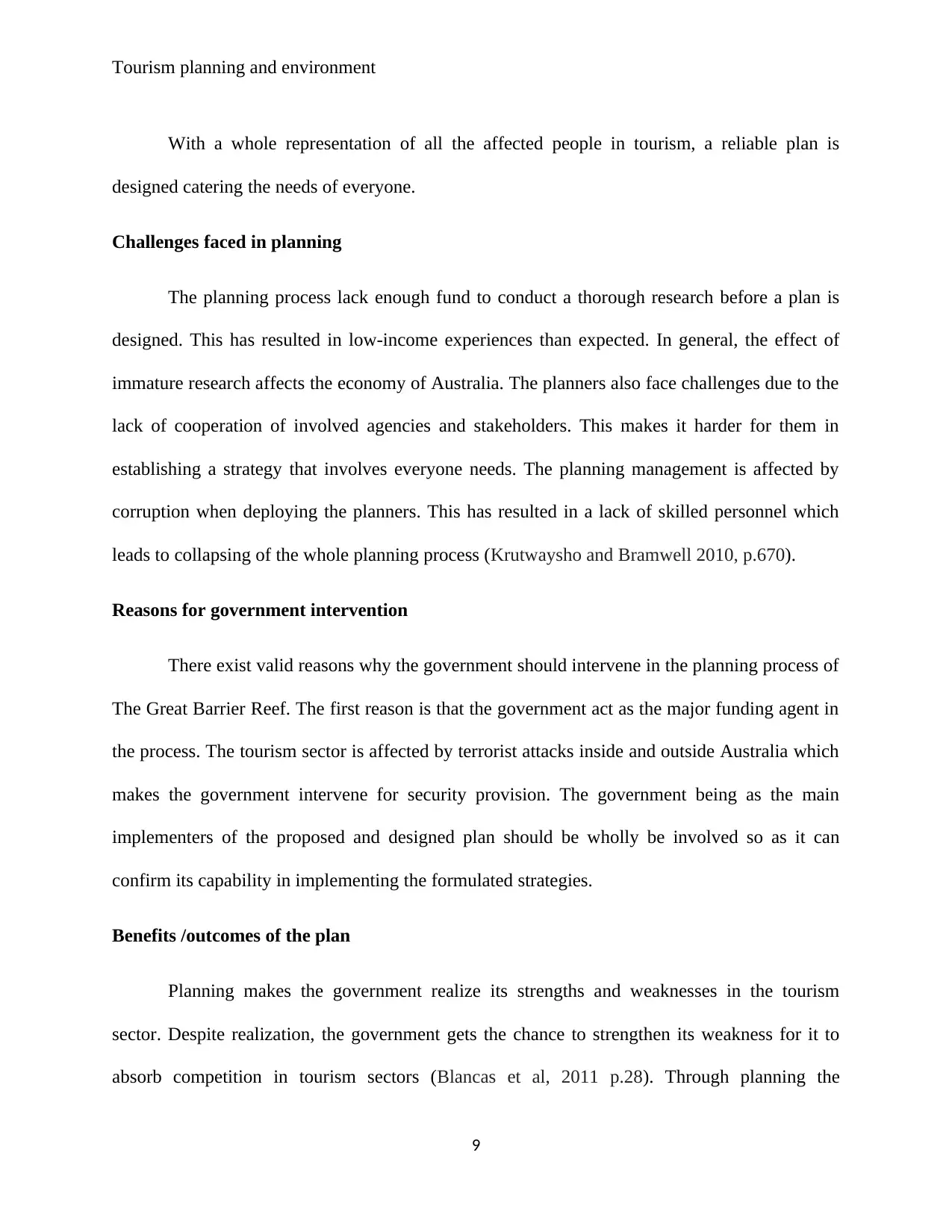
Tourism planning and environment
With a whole representation of all the affected people in tourism, a reliable plan is
designed catering the needs of everyone.
Challenges faced in planning
The planning process lack enough fund to conduct a thorough research before a plan is
designed. This has resulted in low-income experiences than expected. In general, the effect of
immature research affects the economy of Australia. The planners also face challenges due to the
lack of cooperation of involved agencies and stakeholders. This makes it harder for them in
establishing a strategy that involves everyone needs. The planning management is affected by
corruption when deploying the planners. This has resulted in a lack of skilled personnel which
leads to collapsing of the whole planning process (Krutwaysho and Bramwell 2010, p.670).
Reasons for government intervention
There exist valid reasons why the government should intervene in the planning process of
The Great Barrier Reef. The first reason is that the government act as the major funding agent in
the process. The tourism sector is affected by terrorist attacks inside and outside Australia which
makes the government intervene for security provision. The government being as the main
implementers of the proposed and designed plan should be wholly be involved so as it can
confirm its capability in implementing the formulated strategies.
Benefits /outcomes of the plan
Planning makes the government realize its strengths and weaknesses in the tourism
sector. Despite realization, the government gets the chance to strengthen its weakness for it to
absorb competition in tourism sectors (Blancas et al, 2011 p.28). Through planning the
9
With a whole representation of all the affected people in tourism, a reliable plan is
designed catering the needs of everyone.
Challenges faced in planning
The planning process lack enough fund to conduct a thorough research before a plan is
designed. This has resulted in low-income experiences than expected. In general, the effect of
immature research affects the economy of Australia. The planners also face challenges due to the
lack of cooperation of involved agencies and stakeholders. This makes it harder for them in
establishing a strategy that involves everyone needs. The planning management is affected by
corruption when deploying the planners. This has resulted in a lack of skilled personnel which
leads to collapsing of the whole planning process (Krutwaysho and Bramwell 2010, p.670).
Reasons for government intervention
There exist valid reasons why the government should intervene in the planning process of
The Great Barrier Reef. The first reason is that the government act as the major funding agent in
the process. The tourism sector is affected by terrorist attacks inside and outside Australia which
makes the government intervene for security provision. The government being as the main
implementers of the proposed and designed plan should be wholly be involved so as it can
confirm its capability in implementing the formulated strategies.
Benefits /outcomes of the plan
Planning makes the government realize its strengths and weaknesses in the tourism
sector. Despite realization, the government gets the chance to strengthen its weakness for it to
absorb competition in tourism sectors (Blancas et al, 2011 p.28). Through planning the
9
⊘ This is a preview!⊘
Do you want full access?
Subscribe today to unlock all pages.

Trusted by 1+ million students worldwide
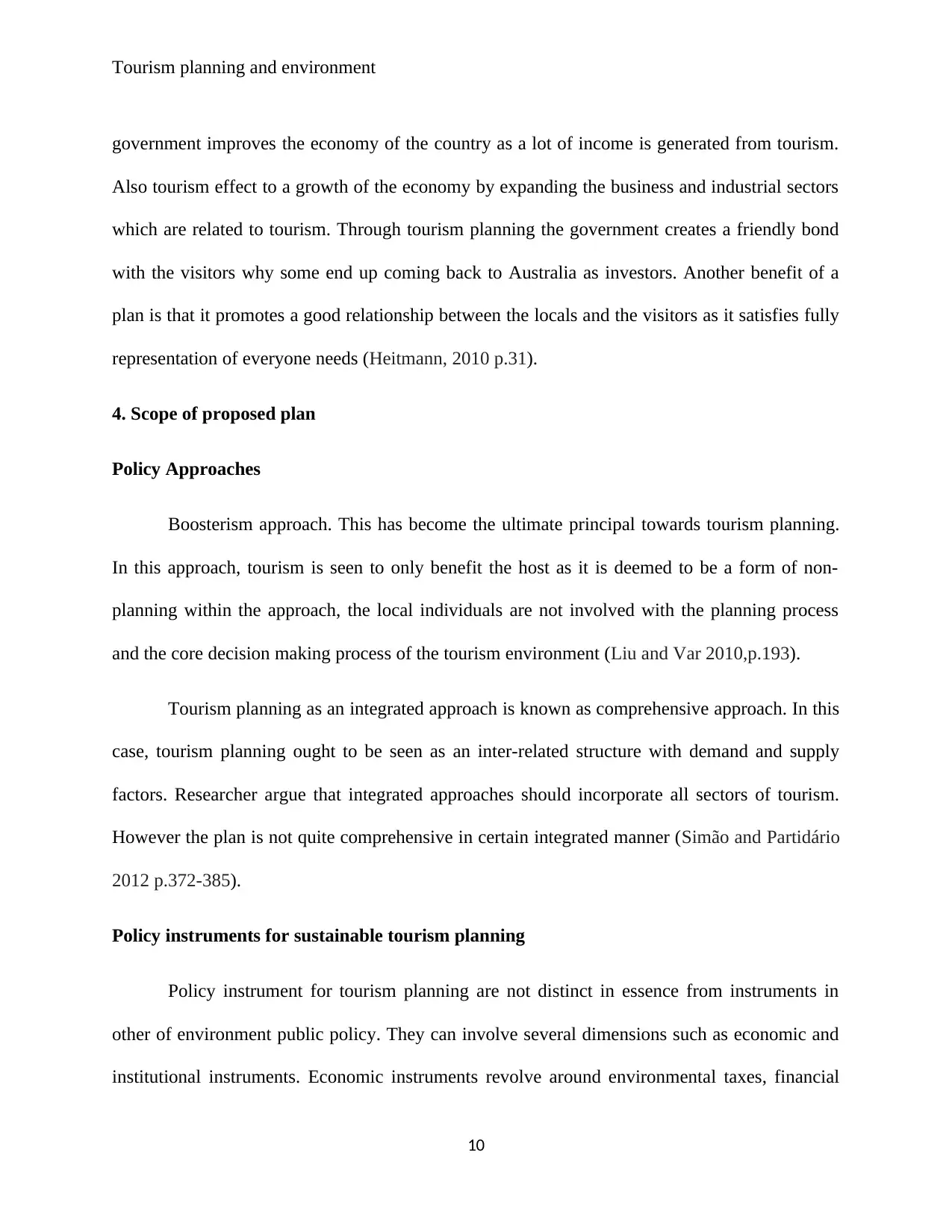
Tourism planning and environment
government improves the economy of the country as a lot of income is generated from tourism.
Also tourism effect to a growth of the economy by expanding the business and industrial sectors
which are related to tourism. Through tourism planning the government creates a friendly bond
with the visitors why some end up coming back to Australia as investors. Another benefit of a
plan is that it promotes a good relationship between the locals and the visitors as it satisfies fully
representation of everyone needs (Heitmann, 2010 p.31).
4. Scope of proposed plan
Policy Approaches
Boosterism approach. This has become the ultimate principal towards tourism planning.
In this approach, tourism is seen to only benefit the host as it is deemed to be a form of non-
planning within the approach, the local individuals are not involved with the planning process
and the core decision making process of the tourism environment (Liu and Var 2010,p.193).
Tourism planning as an integrated approach is known as comprehensive approach. In this
case, tourism planning ought to be seen as an inter-related structure with demand and supply
factors. Researcher argue that integrated approaches should incorporate all sectors of tourism.
However the plan is not quite comprehensive in certain integrated manner (Simão and Partidário
2012 p.372-385).
Policy instruments for sustainable tourism planning
Policy instrument for tourism planning are not distinct in essence from instruments in
other of environment public policy. They can involve several dimensions such as economic and
institutional instruments. Economic instruments revolve around environmental taxes, financial
10
government improves the economy of the country as a lot of income is generated from tourism.
Also tourism effect to a growth of the economy by expanding the business and industrial sectors
which are related to tourism. Through tourism planning the government creates a friendly bond
with the visitors why some end up coming back to Australia as investors. Another benefit of a
plan is that it promotes a good relationship between the locals and the visitors as it satisfies fully
representation of everyone needs (Heitmann, 2010 p.31).
4. Scope of proposed plan
Policy Approaches
Boosterism approach. This has become the ultimate principal towards tourism planning.
In this approach, tourism is seen to only benefit the host as it is deemed to be a form of non-
planning within the approach, the local individuals are not involved with the planning process
and the core decision making process of the tourism environment (Liu and Var 2010,p.193).
Tourism planning as an integrated approach is known as comprehensive approach. In this
case, tourism planning ought to be seen as an inter-related structure with demand and supply
factors. Researcher argue that integrated approaches should incorporate all sectors of tourism.
However the plan is not quite comprehensive in certain integrated manner (Simão and Partidário
2012 p.372-385).
Policy instruments for sustainable tourism planning
Policy instrument for tourism planning are not distinct in essence from instruments in
other of environment public policy. They can involve several dimensions such as economic and
institutional instruments. Economic instruments revolve around environmental taxes, financial
10
Paraphrase This Document
Need a fresh take? Get an instant paraphrase of this document with our AI Paraphraser
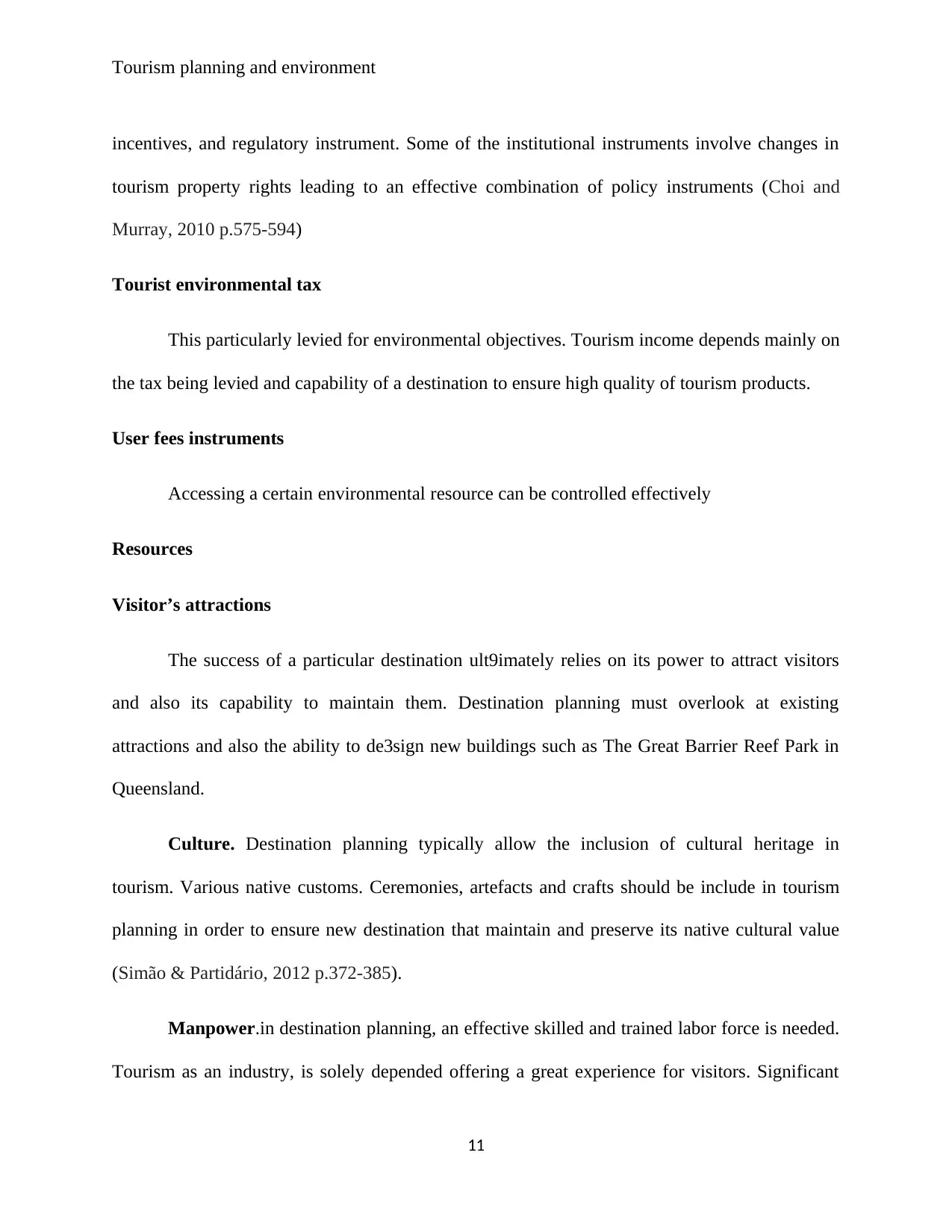
Tourism planning and environment
incentives, and regulatory instrument. Some of the institutional instruments involve changes in
tourism property rights leading to an effective combination of policy instruments (Choi and
Murray, 2010 p.575-594)
Tourist environmental tax
This particularly levied for environmental objectives. Tourism income depends mainly on
the tax being levied and capability of a destination to ensure high quality of tourism products.
User fees instruments
Accessing a certain environmental resource can be controlled effectively
Resources
Visitor’s attractions
The success of a particular destination ult9imately relies on its power to attract visitors
and also its capability to maintain them. Destination planning must overlook at existing
attractions and also the ability to de3sign new buildings such as The Great Barrier Reef Park in
Queensland.
Culture. Destination planning typically allow the inclusion of cultural heritage in
tourism. Various native customs. Ceremonies, artefacts and crafts should be include in tourism
planning in order to ensure new destination that maintain and preserve its native cultural value
(Simão & Partidário, 2012 p.372-385).
Manpower.in destination planning, an effective skilled and trained labor force is needed.
Tourism as an industry, is solely depended offering a great experience for visitors. Significant
11
incentives, and regulatory instrument. Some of the institutional instruments involve changes in
tourism property rights leading to an effective combination of policy instruments (Choi and
Murray, 2010 p.575-594)
Tourist environmental tax
This particularly levied for environmental objectives. Tourism income depends mainly on
the tax being levied and capability of a destination to ensure high quality of tourism products.
User fees instruments
Accessing a certain environmental resource can be controlled effectively
Resources
Visitor’s attractions
The success of a particular destination ult9imately relies on its power to attract visitors
and also its capability to maintain them. Destination planning must overlook at existing
attractions and also the ability to de3sign new buildings such as The Great Barrier Reef Park in
Queensland.
Culture. Destination planning typically allow the inclusion of cultural heritage in
tourism. Various native customs. Ceremonies, artefacts and crafts should be include in tourism
planning in order to ensure new destination that maintain and preserve its native cultural value
(Simão & Partidário, 2012 p.372-385).
Manpower.in destination planning, an effective skilled and trained labor force is needed.
Tourism as an industry, is solely depended offering a great experience for visitors. Significant
11
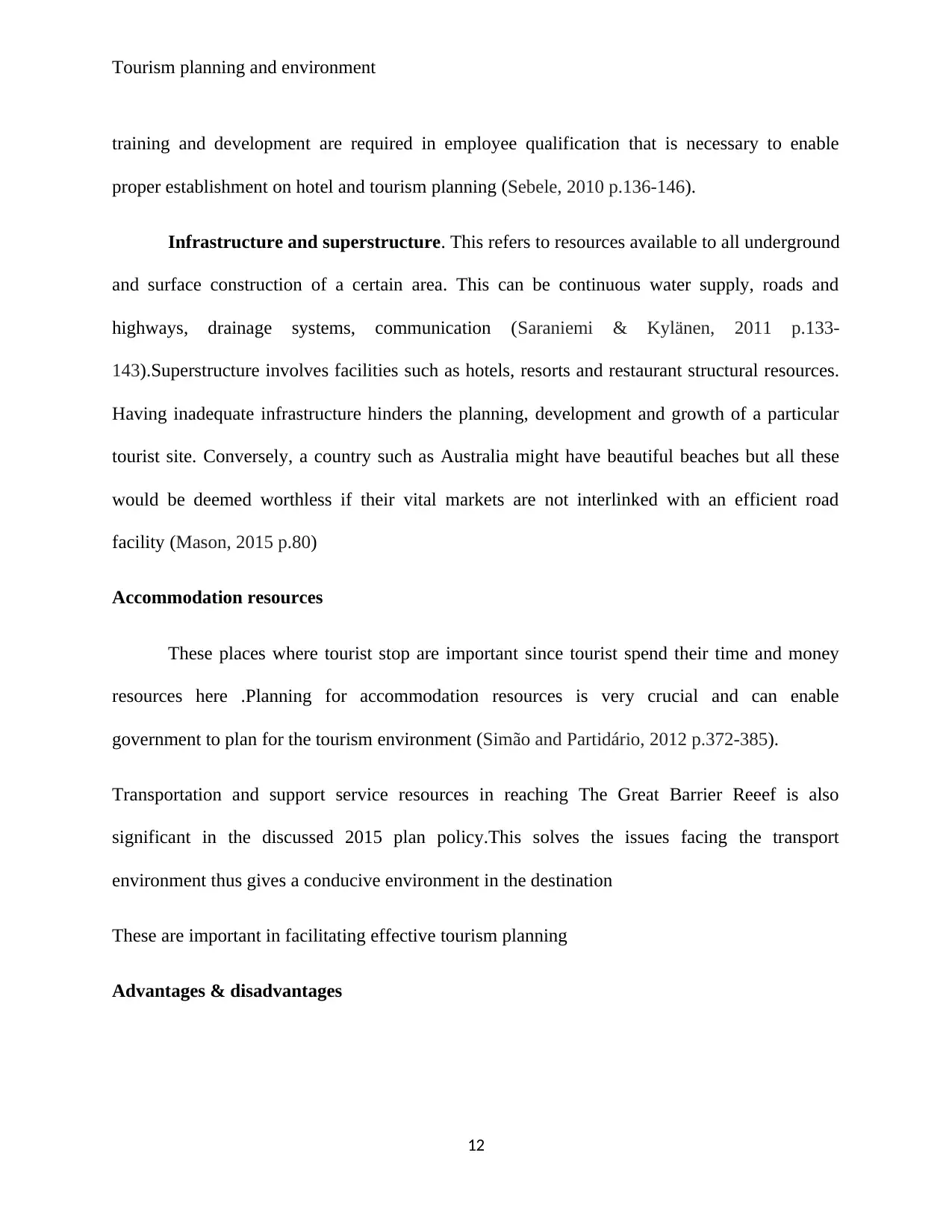
Tourism planning and environment
training and development are required in employee qualification that is necessary to enable
proper establishment on hotel and tourism planning (Sebele, 2010 p.136-146).
Infrastructure and superstructure. This refers to resources available to all underground
and surface construction of a certain area. This can be continuous water supply, roads and
highways, drainage systems, communication (Saraniemi & Kylänen, 2011 p.133-
143).Superstructure involves facilities such as hotels, resorts and restaurant structural resources.
Having inadequate infrastructure hinders the planning, development and growth of a particular
tourist site. Conversely, a country such as Australia might have beautiful beaches but all these
would be deemed worthless if their vital markets are not interlinked with an efficient road
facility (Mason, 2015 p.80)
Accommodation resources
These places where tourist stop are important since tourist spend their time and money
resources here .Planning for accommodation resources is very crucial and can enable
government to plan for the tourism environment (Simão and Partidário, 2012 p.372-385).
Transportation and support service resources in reaching The Great Barrier Reeef is also
significant in the discussed 2015 plan policy.This solves the issues facing the transport
environment thus gives a conducive environment in the destination
These are important in facilitating effective tourism planning
Advantages & disadvantages
12
training and development are required in employee qualification that is necessary to enable
proper establishment on hotel and tourism planning (Sebele, 2010 p.136-146).
Infrastructure and superstructure. This refers to resources available to all underground
and surface construction of a certain area. This can be continuous water supply, roads and
highways, drainage systems, communication (Saraniemi & Kylänen, 2011 p.133-
143).Superstructure involves facilities such as hotels, resorts and restaurant structural resources.
Having inadequate infrastructure hinders the planning, development and growth of a particular
tourist site. Conversely, a country such as Australia might have beautiful beaches but all these
would be deemed worthless if their vital markets are not interlinked with an efficient road
facility (Mason, 2015 p.80)
Accommodation resources
These places where tourist stop are important since tourist spend their time and money
resources here .Planning for accommodation resources is very crucial and can enable
government to plan for the tourism environment (Simão and Partidário, 2012 p.372-385).
Transportation and support service resources in reaching The Great Barrier Reeef is also
significant in the discussed 2015 plan policy.This solves the issues facing the transport
environment thus gives a conducive environment in the destination
These are important in facilitating effective tourism planning
Advantages & disadvantages
12
⊘ This is a preview!⊘
Do you want full access?
Subscribe today to unlock all pages.

Trusted by 1+ million students worldwide
1 out of 19
Related Documents
Your All-in-One AI-Powered Toolkit for Academic Success.
+13062052269
info@desklib.com
Available 24*7 on WhatsApp / Email
![[object Object]](/_next/static/media/star-bottom.7253800d.svg)
Unlock your academic potential
Copyright © 2020–2025 A2Z Services. All Rights Reserved. Developed and managed by ZUCOL.





